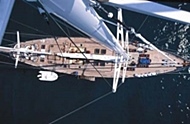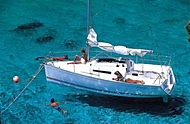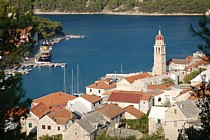
Pucisca Brac island
Pucisca is a settlement in the middle part of the northern part of the island Brac turned to the channel of Brac, Omis and Makarska. The settlement originated on stone, at stone and from stone. ith 1706 inhabitants, along with Supetar, this is the biggest town on Brac with original Mediterranean characteristics. Its white roofs are creating a true ambient atmosphere. It is located at the bottom of a deep bay which splits into two smaller bays: Puciski dolac and Stipanska luka.Pucisca is rich of stones and exactly the excellent local stone has contributed o the development of the town. The work with the stone and the life from it are brought over from generation to generation. Nowadays a stonemason- school is working there. Many palaces throughout the world have been built with the local stone from the renaissance age until today. The works (mainly sculptures) of contemporary domestic and foreign sculptors are set on many public places, which are from the same stone. Other economy branches are cattle-breeding and agriculture.
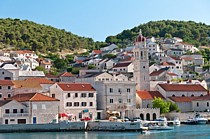 The surrounding of Pucisca, like the whole island Brac, is famous for the production of olive-oil, vine, and figs. Since ages sheep and goats were raised. Thanks to the various Mediterranean plants and grasses, and the sea and mountain air on the higher locations Brac is a true paradise. The historic Plinius the older (24.-29. A.D.) wrote about Brac as a place where excellent goats are raised: "capris laudata Brattia" (by goats praised Brac).
The surrounding of Pucisca, like the whole island Brac, is famous for the production of olive-oil, vine, and figs. Since ages sheep and goats were raised. Thanks to the various Mediterranean plants and grasses, and the sea and mountain air on the higher locations Brac is a true paradise. The historic Plinius the older (24.-29. A.D.) wrote about Brac as a place where excellent goats are raised: "capris laudata Brattia" (by goats praised Brac).
Tourist offer
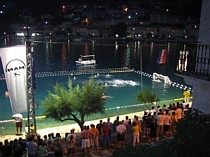 The diligent people of Pucisca are always searching and discovering other natural blessings. In this way they find and strengthen their position in the tourist offer. Directly in the heart of the town is the hotel Porat with 15 beds, and by the parish church the recently opened family hotel "Deskovic", which developed from the former Palace Deskovic.
The diligent people of Pucisca are always searching and discovering other natural blessings. In this way they find and strengthen their position in the tourist offer. Directly in the heart of the town is the hotel Porat with 15 beds, and by the parish church the recently opened family hotel "Deskovic", which developed from the former Palace Deskovic.
This hotel is a building with four stars, and has a restaurant which will surely make your palates happy, a vinoteque and a galery. There are a few excellent restaurants, taverns/ konobas, the garden restaurant Aquila, many coffee bars, pizzerias, a cake-shop, and a hotel inside the Pupils Home of the Stone-mason school.
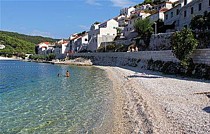 The beaches are with gravel and stones, with a lot of small bays, were everybody can find his intimate corner. Constantly new beaches are being arranged, which are especially suitable for small children. Those who want can choose their holiday in a villa in Praznice or Gornji Humac where especially children have the opportunity to experience the rural Brac. The Robinson type of tourism is also represented - only you, the sea and the sun. The beauty of Pucisca is eternal - therefore the perfect harmony of stone and tourism in this place of sun, stone and salt is not a question at all.
The beaches are with gravel and stones, with a lot of small bays, were everybody can find his intimate corner. Constantly new beaches are being arranged, which are especially suitable for small children. Those who want can choose their holiday in a villa in Praznice or Gornji Humac where especially children have the opportunity to experience the rural Brac. The Robinson type of tourism is also represented - only you, the sea and the sun. The beauty of Pucisca is eternal - therefore the perfect harmony of stone and tourism in this place of sun, stone and salt is not a question at all.
Culture
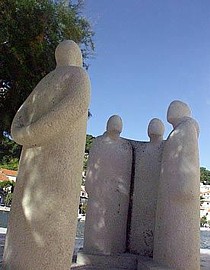 Pucisca have been and still are a strong cultural centre of Brac. Already in 1516 the first private school on the island was established in Pucisca. The chronics Vicko Prodic, Petar Dominis, Trifun Mladinic, Andrija Ciccarelli are famous as well as the writers Jure Zuvetic i Sabo Mladinic. In Pucisca have worked also the very famous stonemasons Juraj Dalmatinac, Andrija Alesi and Nikola Firentinac. The builder and constructor, military engineer Ivan Puljizic was born in Pucisca in the middle of the 17th century and he worked on the court of the Pope Inocent X. From Pucisca is also Trifun Bokanic, the outstanding builder of the third floor of the cathedral in Trogir. Here are also born the two best sculptors from Brac Branko Deskovic and Valerije Michieli.
Pucisca have been and still are a strong cultural centre of Brac. Already in 1516 the first private school on the island was established in Pucisca. The chronics Vicko Prodic, Petar Dominis, Trifun Mladinic, Andrija Ciccarelli are famous as well as the writers Jure Zuvetic i Sabo Mladinic. In Pucisca have worked also the very famous stonemasons Juraj Dalmatinac, Andrija Alesi and Nikola Firentinac. The builder and constructor, military engineer Ivan Puljizic was born in Pucisca in the middle of the 17th century and he worked on the court of the Pope Inocent X. From Pucisca is also Trifun Bokanic, the outstanding builder of the third floor of the cathedral in Trogir. Here are also born the two best sculptors from Brac Branko Deskovic and Valerije Michieli.
A harmonious renaissance building by the castle Ciprijan Zuvetic is outstanding among the monuments of the profane architecture. The castles are a brand-mark of Pucisca and very interesting from the historical point of view as well as from the architectural point. There is also the Palace of the family Moro, today the official building of the Municipality Pucisca, and the Primary school Pucisca from the times of the Austrian- Hungarian government, which opened in 1902, and was totally renewed in 2004.
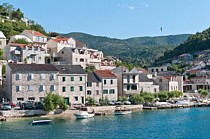 An extraordinary cultural and historical monument is the famous Povaljska listina which is kept in the parish court. According to its original from 1184 it is the oldest preserved document written in Croatian language and Croatian letters. The Listina is one of our oldest and most important language monuments in general. The most monumental sacral monument is the parish church of St. Jerolim, built in 1566 and spread in 1750. There is also the church of the Blessed Virgin Mary with a bell-tower and the cemetery in Botak. Around the church of St. Stephen, on the local cemetery are found one of the oldest settlement: a pagan altar and a Roman grave stela. Almost a trademark of Pucisca is the small church of St. George on Bracuta, right from the road to Postira.
An extraordinary cultural and historical monument is the famous Povaljska listina which is kept in the parish court. According to its original from 1184 it is the oldest preserved document written in Croatian language and Croatian letters. The Listina is one of our oldest and most important language monuments in general. The most monumental sacral monument is the parish church of St. Jerolim, built in 1566 and spread in 1750. There is also the church of the Blessed Virgin Mary with a bell-tower and the cemetery in Botak. Around the church of St. Stephen, on the local cemetery are found one of the oldest settlement: a pagan altar and a Roman grave stela. Almost a trademark of Pucisca is the small church of St. George on Bracuta, right from the road to Postira.
Today Pucisca have a branched cultural activity which reflect itself in many cultural manifestations, especially in the Cultural Summer-festival - concerts of classical, pop and jazz music, performance of klapa (traditional a-capella music), exhibitions, guest theatres, lectures, promotion of books, literature evenings, and various sports- events. Already eight years acts the International Summer Music- school, and the third year the Summer Music- festival of Brac.
Praznica and Gornji Humac
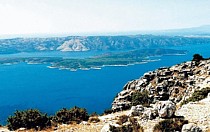 You should not miss to visit the villages Praznica and Gornji Humac in the area of the municipality Pucisca. Praznica is an old settlement from the Middle age about 7 km south of Pucisca, at an altitude of 391 m and with 350 inhabitants, who are living mainly from agriculture and cattle-breeding. Almost every road leads to a church. The oldest church is consecrated to St. Ciprian and originates from the 11th century. The parish church of St. Ante was built in the year 1461. Around Praznice are a huger number of piles of pre- historical tombstones.
You should not miss to visit the villages Praznica and Gornji Humac in the area of the municipality Pucisca. Praznica is an old settlement from the Middle age about 7 km south of Pucisca, at an altitude of 391 m and with 350 inhabitants, who are living mainly from agriculture and cattle-breeding. Almost every road leads to a church. The oldest church is consecrated to St. Ciprian and originates from the 11th century. The parish church of St. Ante was built in the year 1461. Around Praznice are a huger number of piles of pre- historical tombstones.
Gornji Humac is one of the oldest existing settlements of shepherds and farmers on the island. The place is 13 km away from Pucisca, from Supetar 24 km, and from Bol 10 km. The most impressive building is the parish church of St.Nikola. The place completely burned out in a fire in 1943, and it has risen from the ashes like the Phoenix. Today Gornji Humac is proud of its numerous picturesque taverns/ konobas and inns. The one who visit these villages will never forget how important clean and fresh air is. The ecological domestic dishes will rest in a nice memory. You will surely want to come again.





